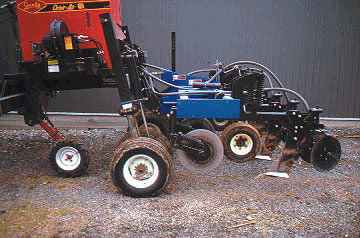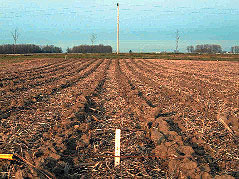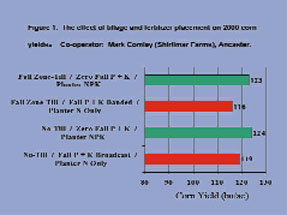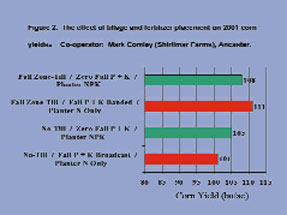
Seeking Fall Fertilizer Efficiency
 Efforts to develop an efficient strip tillage system have also included an examination of fall fertilizer banding. Ideally, the goal was to define a system where phosphorus and potassium could be placed in the fall during the strip tillage operation, eliminating the need to have fertilizer on the planter.
Efforts to develop an efficient strip tillage system have also included an examination of fall fertilizer banding. Ideally, the goal was to define a system where phosphorus and potassium could be placed in the fall during the strip tillage operation, eliminating the need to have fertilizer on the planter.
Combining fertilizer placement during fall strip tillage is an approach that may effectively reduce costs by merging two or three operations into one. The effectiveness of banding fertilizer in the fall for next year’s corn crop is still unproven. Minnesota studies concluded that banding potassium in a ridge tillage system enhanced yields even when soil tests predicted no yield response. Ontario research (Tony Vyn, U. of Guelph) has looked at deep-banding significant amounts of potassium in a fall strip-till system for corn and found no advantage over the more traditional starter banding via the corn planter.
 A Minnesota study compared various tillage systems and phosphorous placement techniques including a fall strip tillage system. Some of the results from this work are highlighted in Table 1. Where corn followed soybeans, researchers compared two conservation tillage systems, one a single pass with a field cultivator in the spring, the other a fall strip tillage system followed by direct planting into the zones in the spring. On average, there was very little difference in corn yields between the tillage systems. In this study, phosphorous placement techniques included no P, P via the planter, and P banded in the fall. Fall banding of P in the plots to be spring-cultivated was performed so that the fall band (5 inches deep) was not located continuously under the corn row, but varied from directly under the row to as much as 15 inches from the row. P banded via the strip tillage operation was done using two methods. Method one was to place P (5 inches deep) directly in line with next year’s corn row, with this band fixed in the same position for each year of corn production. Method two was to offset the fall bands 8 inches from the previous band application. All yields were assessed in adjacent sites, one with high soil test P and one with low soil test P.
A Minnesota study compared various tillage systems and phosphorous placement techniques including a fall strip tillage system. Some of the results from this work are highlighted in Table 1. Where corn followed soybeans, researchers compared two conservation tillage systems, one a single pass with a field cultivator in the spring, the other a fall strip tillage system followed by direct planting into the zones in the spring. On average, there was very little difference in corn yields between the tillage systems. In this study, phosphorous placement techniques included no P, P via the planter, and P banded in the fall. Fall banding of P in the plots to be spring-cultivated was performed so that the fall band (5 inches deep) was not located continuously under the corn row, but varied from directly under the row to as much as 15 inches from the row. P banded via the strip tillage operation was done using two methods. Method one was to place P (5 inches deep) directly in line with next year’s corn row, with this band fixed in the same position for each year of corn production. Method two was to offset the fall bands 8 inches from the previous band application. All yields were assessed in adjacent sites, one with high soil test P and one with low soil test P.
 At both high and low testing sites, corn yields in the one-pass cultivation system were significantly lower when P was banded in the fall than those achieved with starter P placement. At the low testing site only, significantly lower yields than those obtained with starter P were obtained with P banding in the fall strip tillage if the bands were offset year to year. If fall P via strip tillage was placed in the same in-row position from year to year, no significant yield reductions were detected.
At both high and low testing sites, corn yields in the one-pass cultivation system were significantly lower when P was banded in the fall than those achieved with starter P placement. At the low testing site only, significantly lower yields than those obtained with starter P were obtained with P banding in the fall strip tillage if the bands were offset year to year. If fall P via strip tillage was placed in the same in-row position from year to year, no significant yield reductions were detected.
The importance of fall fertilizer band position is also evident from our work in Ontario. The consensus to date is that P and K applications via strip tillage in the fall may be too deep to providestarter fertilizer benefits to the following corn crop. Our approach has been to apply P and K in the fall and then see if we could get away with nitrogen only on the corn planter the following spring. On a number of sites, we have seen reduced yields where the corn had been planted in the absence of a spring starter band. More recently we have investigated shallower fall banding applications, moving from an average of 6-inch deep bands to 4-inch deep bands.
 Figures 1 and 2 represent some of our tentative findings at a site near Ancaster, Ontario. Soil test levels were medium for both P and K at these sites. Some of the benefits of strip tillage at this site have been less need for additional coulters or weight on the corn planter, and in many cases, drier seed beds allowing for the possibility of earlier planting. Figure 1 shows corn yields where the banding of P and K in the fall of 1999 was done deeper (6-7 inches). The nitrogen-only planting treatments (elimination of spring-applied P and K) resulted in yield losses compared to the NPK starter banding plots. In the fall of 2000 on an adjacent site, the P and K banding in the fall was done shallower (roughly 4 inches). 2001 yield results (Figure 2) indicated that corn yields were not depressed by having nitrogen only applied through the planter when being planted on top of the fall-tilled, fertilized zone.
Figures 1 and 2 represent some of our tentative findings at a site near Ancaster, Ontario. Soil test levels were medium for both P and K at these sites. Some of the benefits of strip tillage at this site have been less need for additional coulters or weight on the corn planter, and in many cases, drier seed beds allowing for the possibility of earlier planting. Figure 1 shows corn yields where the banding of P and K in the fall of 1999 was done deeper (6-7 inches). The nitrogen-only planting treatments (elimination of spring-applied P and K) resulted in yield losses compared to the NPK starter banding plots. In the fall of 2000 on an adjacent site, the P and K banding in the fall was done shallower (roughly 4 inches). 2001 yield results (Figure 2) indicated that corn yields were not depressed by having nitrogen only applied through the planter when being planted on top of the fall-tilled, fertilized zone.
Further work needs to be done to confirm that fall fertilizer placement can be done within a strip tillage system without losses in corn yield or fieldwork efficiencies. Indications are at this point in time that fall banding operations need to be particularly concerned with depth of placement and perhaps with the orientation of previous bands as well.
| Table 1 The effect of tillage and phosphorous placement techniques on corn yields. Averages from 1997- 2000 on a clay loam soil in Waseca, Minnesota. |
|||
| Tillage System | Phosphorous Application Method |
Corn Yield (bu/ac) |
|
High P Site |
Low P Site |
||
| Spring Field Cultivate (one pass) | None |
168 |
104 |
Starter (via planter) |
171 |
153 |
|
Fall Band |
164 |
144 |
|
| Fall Strip Tillage | None |
164 |
103 |
Starter (via planter) |
169 |
151 |
|
Fall Band (fixed) |
164 |
147 |
|
Fall Band (off-set) |
169 |
139 |
|
| Note: Where P2O5 was applied, rates were 50 lbs/ac on low testing site and 40 lbs/acre on high testing site. | |||
| G. W. Randall, J.A. Vetsch, University of Minnesota, and T.S. Murrell, Potash and Phosphate Institute. | |||